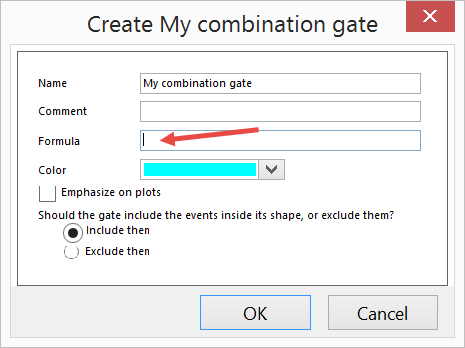Using Boolean Logic to Create Combination Gates
Creating Combination Gates
Combination gates consist of combinations of other gates. To combine gates, you create a gating formula consisting of Boolean combinations of pre-existing gates. Gating formulas are defined by either a single gate or several gates joined by Boolean operators. The operators describe how the gating regions should be combined and follow the rules of Boolean algebra. FCS Express supports the following operators:
•AND
AND is represented by typing 'a', 'A', or 'and' into the gating formula. If you enter the gating formula "1 a 2" (read as, 1 and 2), only events that fall into both gate 1 and gate 2 are selected.
•OR
OR is represented by typing 'o', 'O', or 'or' into the gating formula. If you enter the gating formula "1 o 2" (read as, 1 or 2), all events that fall into either gate 1 or gate 2 are selected.
•NOT
NOT is represented by typing 'n', 'N', or 'not' into the gating formula. If you enter the gating formula "n1" (read as, not 1), all events except the events in gate 1 are selected.
•XOR
XOR is represented by typing 'x' or 'X' or 'xor' into the gating formula. If you enter the gating formula "1 x 2" (read as, 1 xor 2), only events that fall into gate 1 or gate 2, but not both, are selected. Note: XOR stands for exclusive Or. The difference between 'or' and 'xor' is that with 'or' an event that falls into both regions is selected, while with 'xor' an event that falls into both regions is excluded from selection.
Together with the four Boolean operators, Combination Gates can be created using parentheses. The contents of the innermost parentheses are evaluated first, and the remainder of the equation is evaluated from left to right. This allows you to build complex gating formulas quite easily. The following are examples of some valid gating formulas. Note: Spaces are not required when inputting the formula into FCS Express some people prefer to use then to make complex formulas more readable.
•"not lymphocytes or monocytes"
Events that are not in lymphocytes or are in monocytes are selected. The NOT is only applied to the lymphocytes if you do not use parentheses.
•"n (lymphocytes or monocytes)"
First the "(lymphocytes or monocytes)" is evaluated, then a NOT is applied. Now all events that are not in the lymphocytes gate and not in the monocytes gate are selected. The formula "Not lymphocytes And Not monocytes" would have the same result.
•"(lymphocytes and monocytes) or (granulocytes and blasts)"
Events that are in both the lymphocytes and monocytes gates, or both the granulocytes and blasts gates are selected. Because 'and' means events must be in both gates to be selected, the only events that will be selected will be those that fall in the overlap between the lymphocytes and monocytes gate OR the overlap between the granulocytes and blasts gates.
Combination gates are created in the following way:
•After inserting a Gate View object onto the layout (Insert→General→Gate View), right-click on the Gate View and select Add Combination Gate from the pop-up menu.
A dialog box (Figure 9.23) will appear. Select the Formula field and enter Boolean operators and the names of preexisting gates. As you type, FCS Express will determine which gate or Boolean operator you are trying to type and will attempt to complete the word for you via autofill. If more than one gate or operator matches the letters you’ve typed, you can scroll through the available matches by using the arrow keys. Press the space bar to accept the choice.

Figure 9.23 Creating a Combination Gate
